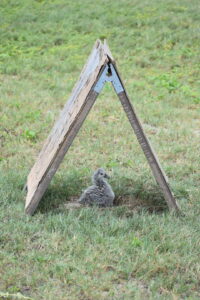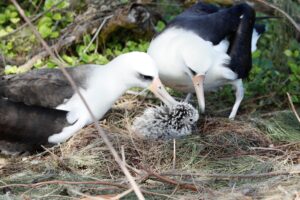An Introduction to the Laysan Albatross
By: Kate Behrens
Midway Atoll National Wildlife Refuge is nesting ground to Wisdom, the oldest known, banded wild bird in the world. A female Laysan albatross, Wisdom is at least 69 years old and is still laying eggs with her partner. Laysan albatross or Mōlī, known for their dynamic soaring and unique courtship displays, are difficult to study because 90% of their life is spent at sea (USFWS 2019). The observable 10% occurs when the birds return to breeding colonies to find a mate and fledge chicks.
Young Laysan albatross do not return to their breeding colony until they are at least three years old. Upon return, the young bird will begin to practice the alternating and simultaneous movements of a ritualized courtship dance to attract a mate. The juvenile albatrosses will gather in groups of two or three to learn the dozens of postures and while there are many individual movements, often they are grouped into four sets: Eh-Eh Bow-Stare and Whinny-Head Flick-Rapid Bill Clapper, Air Snap-Bill Under Wing-Sky Snap, Stare-Sky Call, and Head Shake and Whine-Stare-Head Flick-Rapid Bill Clapper (Meseth 1975). Additional movements include touching bills, spreading one or both wings, bobbing their heads, placing their bill under one wing, and pausing with their bill pointed towards the sky. After years of practice, the seabirds will eventually find a mate and the pair will stay bonded for life. Raising young is incredibly demanding on the pair and it will often take three or four years before the pair successfully hatches their first chick (USFWS 2005).

Females usually lay one egg per year in November or December, occasionally skipping a year in between (Keller et al. 2009). After the female lays the egg, she will leave the nest for several weeks to restore her body condition while the male incubates the egg. Once she returns, the pair will take turns throughout the rest of the incubation period. After about 64 days, the chick will begin a three-day process called “pipping” where the chick uses their egg tooth, a hard projection on their bill, to chip at the shell until the hole is large enough to emerge. The young bird is tended to by both parents who remain together for the first few days and then take turns  staying with the chick and foraging for food (DLNR 2005). When the female to male ratio is out of balance, occasionally two females will pair up to raise a chick. One or both of the females will mate with a neighboring male and then raise one of the eggs. While often not as successful as a female and male bond, this adaptive strategy demonstrates how same-sex pairing is better than not breeding at all (Young and VanderWerf 2014).
staying with the chick and foraging for food (DLNR 2005). When the female to male ratio is out of balance, occasionally two females will pair up to raise a chick. One or both of the females will mate with a neighboring male and then raise one of the eggs. While often not as successful as a female and male bond, this adaptive strategy demonstrates how same-sex pairing is better than not breeding at all (Young and VanderWerf 2014).
As the chick gets older, the parents will begin to leave it alone and stay away for longer periods of time, up to 17 days and traveling 3,000 miles, to gather more food (Keller et al. 2009). After five and a half months of demanding care, the chick will fledge, leaving the nest and heading out to sea, where it will care for itself for a few years before returning to a nesting colony. Much about this time is unknown to researchers.
Laysan albatross are considered near threatened as their environment and breeding grounds are under serious threat due to climate change and sea level rise (USFWS 2005). Additionally, the build-up of plastic in the ocean poses a risk as the seabirds often mistake it for food. Plastic ingestion brings harmful chemicals into the seabird’s systems and can result in punctures to their digestive system leading to starvation, dehydration, and death. Plastic accumulation in the stomach can also give a false sensation of satiation, or feeling full, resulting in starvation because the individual is not gaining proper nutrition. Laysan albatross also fall victim to fishery bycatch as they are unintentionally caught in nets or miles of long line with baited hooks. Efforts to decrease the number of seabird deaths from fishery bycatch have been initiated by the United States with fairly successful results. However, globally, more efforts are necessary.
There are many ways that you can help support the Laysan albatross and their species’ survival. When in the presence of the seabird, remain at least 35 feet (10 meters) from the bird or nest, keep your dog leashed, and minimize talking and noise so as not to disturb the animal. Another way to positively impact the health of the Laysan albatross species is to reduce your use of plastic and move towards a zero-waste lifestyle. Discarded plastic often ends up in the ocean where the albatross eat it and feed it to their young. Lastly, when purchasing seafood, consider utilizing the Monterey Bay Aquarium’s Seafood Watch Program app which offers convenient information about how to choose sustainable seafood in stores and restaurants. Together, we can increase the survival of this incredible species and learn to coexist.
Hawaii Marine Animal Response (HMAR) is a first responder and rescue organization for Hawaiian monk seals, sea turtles and seabirds in need of assistance. If you see an injured, stranded, or entangled seabird on Oahu, please call the HMAR hotline at (808) 220-7802. To report a marine mammal or sea turtle of concern on Oahu, please call the HMAR hotline at (808) 220-7802. Statewide, please call (888) 256-9840. Learn more about HMAR and ways you can help here.

References and further reading:
- Keller, K., Anders, A., Shaffer, S., Kappes, M., Flint, B., & Friedlander, A. 2009. A Marine Biogeographic Assessment of the Northwestern Hawaiian Islands: 235-274.
- Meseth, E. 1975. The Dance of the Laysan Albatross, Diomedea Immutabilis. Behaviour 54 (3-4) 217-257.
- U.S. Department of Land and Natural Resources. 2005. Hawaii’s Comprehensive Wildlife Conservation Strategy.
- U.S. Fish and Wildlife Service. 2019. https://www.fws.gov/refuge/Midway_Atoll/News/Where_Is_Wisdom.html
- U.S. Fish and Wildlife Service. 2005. Seabird Conservation Plan Pacific Region.
- Young, L. and VanderWerf, E. 2014. Adaptive value of same-sex pairing in Laysan albatross. Proceedings of the Royal Society B. 281(1775). https://doi.org/10.1098/rspb.2013.2473
